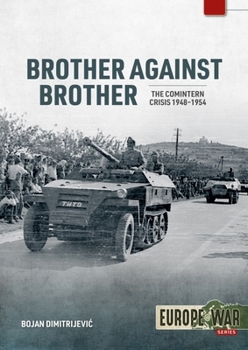Brother Against Brother: The Comintern Crisis 1948-1954
Brother against Brother: The COMINTERN Crisis 1948-1954 describes the first armed conflict in the Communist world after the Second World War, that occurred between Tito's Yugoslavia and the People's Democratic states, headed by the Soviet Union, between 1948 and 1954. Brother against Brother details the process of "Sovietization" of the former Yugoslav Partisan Army, its ambitious development plans and influence in neighboring Albania, Bulgaria and the Greek Civil War, which led to rising suspicions amongst the Soviet leadership, especially Stalin. It would lead to the slow break down of mutual ties in the spring of 1948, and finally the Cominform Resolution on 28 June 1948.
The Resolution marked the start of a conflict that would last for almost seven years. Communist brothers-in-arms became bitter enemies and the Yugoslavian borders with the communist countries of Albania, Bulgaria, Rumania and Hungary became front-lines. The political clash turned into open hostilities at the borders: firing on border-guards, attacks on border posts, intrusions by agents and armed groups, and surveillance and troop movements. Despite the fact that Tito's Yugoslavs were frightened by the expectation of the aggression from the East, it was never launched. The war on the Korean Peninsula turned the attention of both the Soviets and Americans to the Far East.
This book describes the Yugoslav Army's organization, stressing the differences in pre-1948 and later reorganizations during the conflict. It provides the reader with detailed orders of battle of the Yugoslav Army, based on the author's archival research. The book details the attempts of the Yugoslavs to establish an indigenous defense industry during this period in order to overcome the problem of supplying its army, stressing the development of the first Yugoslav tank, a series of piston engine fighters, and several types of vessels for Navy and series of small arms.
During the conflict, the Yugoslav military Counterintelligence Service (KOS) and State Security (UDBA) led the widespread struggle with the Soviet and satellite intelligence services on the borders and in the ranks of the army and security forces. Arrested supporters of Stalin, and those who were engaged by the Soviet and other intelligence services, were sent to camp at Goli Otok (Naked Island) in Adriatic for "re-education."
The Cominform-Yugoslav conflict would come to a gradual end. First, by acceptance of Yugoslavia into the US Mutual Defence Aid Program in November 1951, which led to Tito's army being treated almost on a par with those of NATO's southern European members. And, second, after the death of Stalin in March 1953, which opened the possibilities that the clash should come to an end with Nikita Khrushchev's public apology in Belgrade in mid-1955.
The Resolution marked the start of a conflict that would last for almost seven years. Communist brothers-in-arms became bitter enemies and the Yugoslavian borders with the communist countries of Albania, Bulgaria, Rumania and Hungary became front-lines. The political clash turned into open hostilities at the borders: firing on border-guards, attacks on border posts, intrusions by agents and armed groups, and surveillance and troop movements. Despite the fact that Tito's Yugoslavs were frightened by the expectation of the aggression from the East, it was never launched. The war on the Korean Peninsula turned the attention of both the Soviets and Americans to the Far East.
This book describes the Yugoslav Army's organization, stressing the differences in pre-1948 and later reorganizations during the conflict. It provides the reader with detailed orders of battle of the Yugoslav Army, based on the author's archival research. The book details the attempts of the Yugoslavs to establish an indigenous defense industry during this period in order to overcome the problem of supplying its army, stressing the development of the first Yugoslav tank, a series of piston engine fighters, and several types of vessels for Navy and series of small arms.
During the conflict, the Yugoslav military Counterintelligence Service (KOS) and State Security (UDBA) led the widespread struggle with the Soviet and satellite intelligence services on the borders and in the ranks of the army and security forces. Arrested supporters of Stalin, and those who were engaged by the Soviet and other intelligence services, were sent to camp at Goli Otok (Naked Island) in Adriatic for "re-education."
The Cominform-Yugoslav conflict would come to a gradual end. First, by acceptance of Yugoslavia into the US Mutual Defence Aid Program in November 1951, which led to Tito's army being treated almost on a par with those of NATO's southern European members. And, second, after the death of Stalin in March 1953, which opened the possibilities that the clash should come to an end with Nikita Khrushchev's public apology in Belgrade in mid-1955.
Format:Paperback
Language:English
ISBN:180451215X
ISBN13:9781804512159
Release Date:April 2023
Publisher:Helion & Company
Length:96 Pages
Customer Reviews
0 rating





